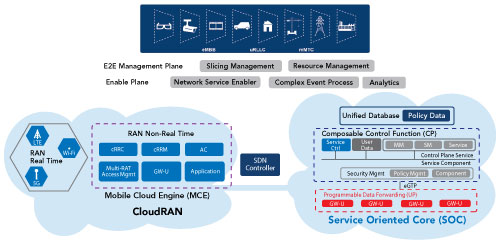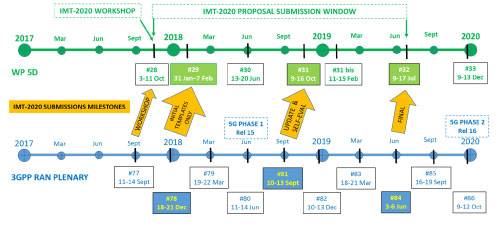Future 5G “Cloud RAN” capabilities (see Figure 2) are meant to support multiple RANs, standards and operators using the same physical infrastructure or core network. Such an adaptable RAN would allow for various applications and industries to rely on the same hardware and network assets, physical infrastructure to pave the way for future opportunities. The system to provide capabilities for service-level agreements for a collection of devices is dubbed “network slicing” by 3GPP.

Figure 2 A new virtualized cloud radio access network architecture will enable operators to serve the multiple use cases envisioned for 5G. Source: Huawei.
The future 5G standard, what will be concluded in the complete 3GPP Release 15, or 5G Phase 1, will be finalized in June 2018 (see Figure 3). Before the end of 2019, 3GPP will provide updates to Release 15, and a clearer vision of Release 16, or 5G Phase 2, will become available in December 2019. Currently, there is little information on how 5G rollouts will occur and what industries, outside of mobile wireless, will begin adopting the capabilities of 5G. Though trials have been performed and early 5G network and radio access hardware is available, UEs have yet to be released, and operators have virtually no experience and limited understanding or expectations of 5G. Furthermore, mmWave hardware is not yet widely available and, without this valuable experience, solidifying 5G mmWave specifications is impractical. The mmWave frequency designations for 5G will not be identified for the ITU until WRC-2019, in time for IMT-2020.

Figure 3 3GPP timeline for 5G specifications. Source: 3GPP.
5G Phase 1 is still based on OFDM waveforms, though there are a variety of candidate waveforms which may eventually supersede OFDM. Specifically, 5G phase 1 leverages cyclic prefix OFDM (CP-OFDM) for the downlink, and both CP-OFDM and discrete Fourier transform spread OFDM-based (DFT-S-OFDM) waveforms for the uplink. 5G Phase 1 allows for flexible subcarrier spacing, where the subcarriers can be spaced at 15 kHz × 2n to a maximum of 240 kHz with a 400 MHz carrier bandwidth. Up to two uplink and four downlink carriers can be used, for a combined uplink bandwidth of 200 MHz and downlink bandwidth of 400 MHz.
CURRENT 5G HARDWARE
For the past few years, many telcos and hardware/platform manufacturers have been engaging in a game of 5G one-upmanship. Early demonstrations included mmWave throughput, mMIMO, CA and a variety of software and hardware examples. Many of the latest 5G trials and demonstrations involved technology more aligned with the upcoming 3GPP Release 15, capable of being updated by software to meet the final 5G Phase 1 specification and future updates.
Hence, many of the recently released and announced 5G modems and transceivers are able to be updated via software, and offer throughput handling capabilities that account for greater bandwidth availability at currently unavailable mmWave frequencies. Many leading hardware manufacturers and telecommunication companies are continuing to push to advance 5G trials and deployments by 2019, well ahead of a final specification, by leveraging NSA 5G NR and technology that can be modified to meet the finalized specifications.10 Given the nature of the race to commercialize 5G, and the likelihood of future 5G specifications adjusting to the findings of early trials and deployments, programmability and flexibility of both the software and hardware of 5G radios and core networks are essential.
Another factor to consider with 5G hardware is not only backward compatibility, but dual connectivity of 4G LTE and 5G systems. Similar to how prior generations of mobile wireless were eventually integrated into the latest specifications, it is likely that current 4G LTE rollouts will be merged into future 5G specifications. Supporting dual connectivity, backward compatibility and future 5G specifications will require highly adaptable RF hardware that can allocate resources based on the actual environment, not just preprogrammed scenarios.11-12
As the finalized 5G mmWave spectrum and radio hardware is not yet determined, and extensive mobility trials with mmWave frequencies are still underway, the first round of 5G mmWave technology will provide fixed wireless service (FWA). This approach minimizes many of the challenges associated with a complete 5G solution, including mmWave mobility concerns around non-line-of-sight and antenna beam tracking with moving UEs. Also, FWA 5G modems and transceiver chips can be larger, use more power and cost more than modem and transceiver chips for UE.
Available 5G modems, typically with integrated 5G transceivers, are offered by Samsung, Qualcomm, Intel, Huawei and others. Some of these early 5G chipsets are reportedly capable of 2 Gbps data rates and mmWave transceiver operation at 28 GHz. Common features include NSA 5G NR compatibility, with a variety of beamforming techniques, antenna switching, 3D frequency planning tools and virtualized RAN.13-14
Currently, device and network hardware manufacturers, with associated telecommunications service providers and test and measurement manufacturers, are engaging in 5G NR trials with simulated UEs. Samsung and National Instruments, as well as Datang Mobile and Keysight Technologies, demonstrated what will likely be commercial 5G base station hardware and 5G UE emulation systems at Mobile World Congress 2018.15-16 It is likely that 5G UE chipsets will become available in 2019, although it is unknown if these UE will leverage mmWave technology or just the sub-6 GHz 5G FR1 frequencies.
The latest commercially available 5G hardware solutions are typically RF front-end (RFFE) modules designed to account for the new NSA 5G NR frequencies, which can be included with other RFFE hardware to offer a complete solution. These RFFEs include power amplifiers (PA), low noise amplifiers (LNA), switches and filters and differ somewhat from 4G RFFEs. As the power Class 2 specification for higher output power (26 dBm at the antenna) is available for 5G hardware, PAs may be higher power than with 4G, necessary to overcome increased propagation losses at higher frequencies through the atmosphere and common building materials.
With 100 MHz of available Tx bandwidth, techniques like envelope tracking—which currently only supports up to 40 MHz of bandwidth—may not be viable; less efficient techniques, such as average power tracking are more likely for early 5G systems. These early 5G RFFE modules will likely be wideband, requiring additional filtering for the new sub-6 GHz 5G bands, as well as the legacy and still necessary 4G bands. These multi-band filters are currently more complex combinations of surface acoustic wave (SAW), bulk acoustic wave (BAW) and film bulk acoustic wave (FBAR) filter banks and integrated modules.
